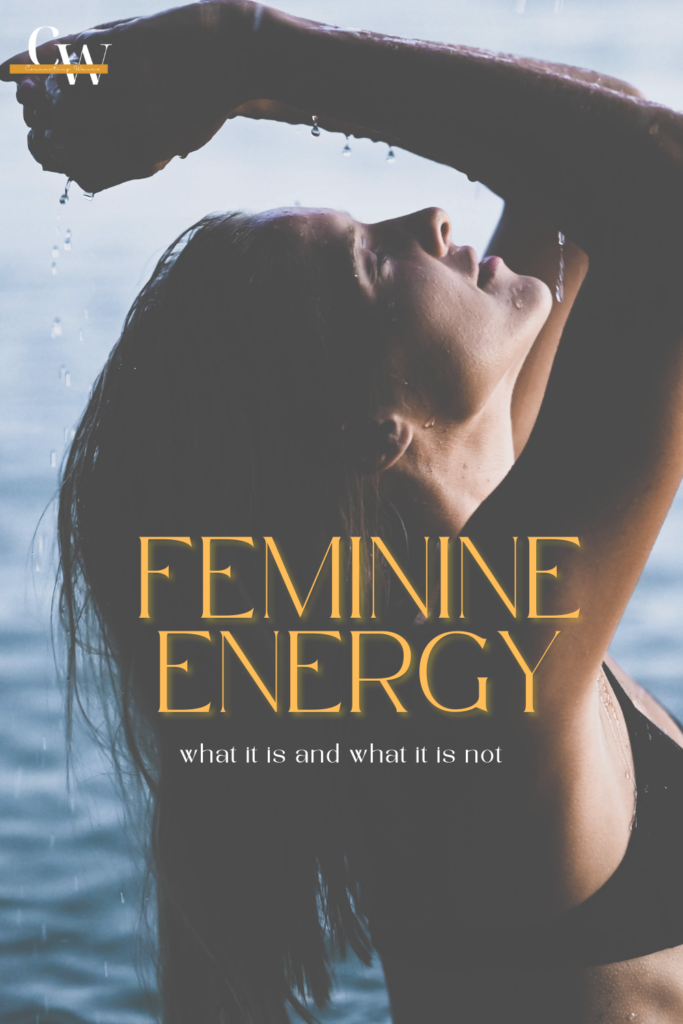Feminine energy, a nuanced and abstract concept, has been a subject of contemplation across diverse cultural, spiritual, and philosophical realms. Rooted in ancient traditions and symbolism, it represents a dynamic force associated with receptivity, intuition, and interconnectedness. Originating from philosophies like Taoism, where it finds expression in the Yin and Yang duality, feminine energy draws inspiration from the natural world, particularly the symbolic interplay of the sun and moon. In the contemporary landscape, its relevance has transcended gender-specific roles, permeating discussions on personal development and societal dynamics. As we navigate an era that calls for greater balance and inclusivity, the exploration of feminine energy becomes not only a reflection of ancient wisdom but a vital lens through which to understand and embody qualities that contribute to the holistic well-being of individuals and the collective.

Historical and Philosophical Foundations
Within the Eastern philosophies, particularly exemplified by Taoism, the exploration of feminine energy reveals a profound understanding of the interplay between opposites and the quest for balance in all aspects of existence. At the heart of this philosophy lies the iconic Yin and Yang symbol, a visual representation of the cosmic duality shaping the universe. In this symbol, the contrasting elements of Yin and Yang embody a dynamic relationship, wherein each contains the seed of the other, and neither can exist in isolation.
Yin, symbolized by the dark, yielding, and receptive aspect, is closely associated with feminine energy. This is not a relegation to gender-specific roles, but rather an acknowledgment of archetypal qualities that transcend physical distinctions. Yin embodies qualities such as receptivity, intuition, nurturing, and a deep connection to the cyclical nature of life. It is within the realm of Yin that the essence of feminine energy is found.
Importantly, the philosophy of Taoism does not posit a hierarchy between Yin and Yang; instead, it emphasizes their interdependence and the necessity of their coexistence. The concept of feminine energy, as represented by Yin, is inherently complementary to the masculine energy represented by Yang. Together, they form a harmonious whole, a cosmic dance where the interdependence of opposites sustains the equilibrium of the Tao—the underlying principle and force that flows through all of existence.
The perception of feminine energy in Taoism extends beyond a mere acknowledgment of opposing forces. It delves into the idea that achieving balance, known as the Taoist concept of “wu wei” or effortless action, involves understanding and harmonizing these complementary energies. By recognizing the vital role played by the receptive and nurturing qualities associated with feminine energy, Taoism teaches that individuals and societies can attain holistic well-being.
This ancient philosophy offers a timeless wisdom that encourages us to embrace the multifaceted nature of existence. In understanding and integrating both Yin and Yang, and appreciating the unique qualities each brings, individuals are invited to navigate life’s complexities with grace and equilibrium. The roots of feminine energy, as explored through the lens of Taoism, thus extend far beyond a cultural or temporal context—they offer a timeless guide for cultivating harmony within ourselves and in the world around us.
Symbolism in Nature
In the intricate language of nature’s symbols, the sun and moon play essential roles in representing the dance between masculine and feminine energies. The sun, with its bright and assertive presence, symbolizes strength and illumination—qualities often linked with the masculine. In contrast, the moon, with its gentle glow and cyclic phases of waxing and waning, embodies receptive and introspective attributes associated with the feminine. This celestial interplay mirrors the dynamic balance between action and receptivity, light and darkness, illustrating the inherent duality present in the concept of feminine energy.
Expanding our gaze to the very ground beneath our feet, Earth itself becomes a powerful symbol of feminine energy, often personified as Mother Earth. This characterization emphasizes the nurturing and life-giving qualities intrinsic to the feminine archetype. Mother Earth provides sustenance for all living beings, serving as a poignant reminder of the interconnectedness that binds us to the planet. This symbolism extends beyond physical nourishment, highlighting the spiritual and metaphorical aspects of feminine energy, urging us to cultivate reciprocity and harmony with our environment.
The symbolism found in nature serves as a profound guide, encouraging us to recognize, honor, and integrate the qualities associated with feminine energy. By doing so, we not only contribute to a more balanced and harmonious existence in our personal lives but also play a vital role in fostering a reciprocal relationship with the Earth and promoting interconnected well-being of all.
Contemporary Perspectives
In 21st century, the exploration of feminine energy has undergone a transformative evolution, transcending traditional cultural and spiritual contexts. In contemporary times, the concept has taken center stage in discussions on personal development and self-help, resonating with individuals across diverse backgrounds and irrespective of gender. This paradigm shift reflects a collective recognition of the value and importance of qualities traditionally associated with the feminine archetype in fostering a holistic and fulfilled life.
In the realms of personal development, the embrace of feminine energy involves a conscious effort to integrate attributes such as receptivity, intuition, and collaborative interconnectedness into one’s daily life. Receptivity, rather than passivity, is seen as a strength—a dynamic quality that allows individuals to tune into their own emotions and the subtle cues of their environment. Intuition, often regarded as a feminine trait, is celebrated as a valuable source of guidance, encouraging individuals to trust their instincts and navigate life with a heightened sense of self-awareness.
Collaborative interconnectedness is another key component emphasized in contemporary discussions about feminine energy. This concept underscores the importance of building meaningful connections, fostering community, and recognizing the interdependence of all individuals. In a world that increasingly values collaboration over competition, the qualities associated with feminine energy, such as empathy and cooperation, are acknowledged as essential for creating positive social change and fostering a sense of belonging and shared purpose.
Moreover, the exploration of feminine energy in the modern era is not confined by gender norms. Both men and women are encouraged to embrace and embody these qualities, recognizing that they contribute to a more balanced and integrated sense of self. This inclusivity aligns with the broader societal movement towards dismantling traditional gender roles and fostering a more egalitarian and understanding society.
As the 21st century unfolds, the exploration of feminine energy stands as a dynamic and relevant aspect of personal growth. It encourages individuals to draw upon a diverse spectrum of qualities, fostering resilience, empathy, and creativity in their journey toward a more fulfilling and harmonious life. In this contemporary context, the recognition and integration of feminine energy contribute to a broader cultural shift towards a more balanced and inclusive understanding of human potential.
What Feminine Energy is:
Receptivity and Intuition: Embraces openness, intuition, and receptivity to emotions and subtle cues.
Nurturing and Compassion: Involves caring for others and oneself, expressing compassion, and fostering connections.
Adaptability and Flow: Values creativity, spontaneity, and the ability to navigate changes with grace.
Collaboration and Connection: Emphasizes collaboration, teamwork, and the interconnectedness of all beings.
Inner Strength and Resilience: Embodies strength through emotional resilience, patience, and enduring challenges with grace.
What Feminine Energy is Not:
Submissiveness or Weakness: It is not synonymous with passivity or weakness; feminine strength operates differently from masculine assertiveness.
Exclusive to Gender: Not confined to women; both men and women can embody feminine energy.
Lack of Boundaries: Does not imply a lack of boundaries; feminine energy can be strong and assertive when necessary.
Rigidity or Control: Does not seek rigid control; it values adaptability and the ability to flow with life.
Dependency: Does not rely on external validation or dependence on others; feminine energy finds strength within.
The recognition and cultivation of feminine energy hold particular relevance in our contemporary landscape as societal structures undergo transformative shifts, emphasizing the call for inclusivity and equality. In this evolving paradigm, traditional notions of strength and success are being redefined to encompass a more holistic understanding that embraces qualities traditionally associated with feminine energy, such as empathy, creativity, and collaborative leadership. As we navigate the complexities of the modern world, the acknowledgment of feminine energy becomes a pivotal guide for both personal growth and societal evolution. This recognition extends beyond gender stereotypes, offering a compass for a more balanced and inclusive future.
In embracing the essence of feminine energy, we move intentionally towards balance and interconnectedness, transcending cultural and spiritual boundaries. The exploration of these qualities becomes a touchstone for navigating the intricacies of contemporary life. Beyond its cultural and spiritual significance, the recognition of feminine energy serves as a beacon illuminating the path towards a more harmonious and inclusive future. It invites us to integrate the wisdom of the ages into our present lives, fostering a world where the dance of masculine and feminine energies creates a symphony of balance and a thriving humanity.
Liked it? Pin it!



More on mindful living HERE



Pingback:Harmony Within: How to Heal the Feminine Energy - Connecting Waves